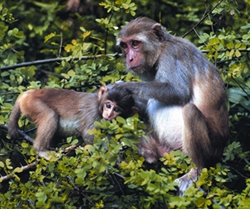Macaque
Macaque (banor) old world monkey of the genus Macaca of the family Cercopithecidae, order Primates; widely distributed in southern Asia and northern Africa. These mammals are typically versatile, intelligent and social animals; most species are tree dwelling and herbivorous, but there is considerable variation in both habitat and diet. There are 10 species of primates in Bangladesh of which 5 are macaques. Except one all the 19 species of macaques that exist today in the world are widely distributed in Asia from Afghanistan to Japan, the Philippines, and Borneo.
The large, tailless Barbary Ape (Macaca sylvanus) on the rock of Gibraltar is the only non-human primate found in Europe and was probably introduced from populations of North Africa. It is in fact a macaque, not an ape, but unlike other macaques the males help care for the young.

The five species of macaques found in Bangladesh are Stumptail Macaque (khatoleji banor), Macaca arctoides; Assamese Macaque (asami banor), Macaca assamensis; Crab-eating Macaque/Long-tailed Macaque (parailla banor/lombaleji banor), Macaca fascicularis; Rhesus Macaque (banor), Macaca mulatta; Pig-tailed Macaque (ultoleji banor/kulu banor), Macaca nemestrina. The macaques are heavily built monkeys, with longer muzzles than their compatriots the langurs, and large naked callosities on the buttocks. The face of macaques is dog-like; cheek pouches allow them to gather a meal of food and then digest it in safety. Like most monkeys, macaques go about in groups, each headed by an old male. They feed on seeds, fruits, insects, lizards, etc, and several of the species are mainly terrestrial. Crab-eating or Long-tailed Macaques are agile swimmers and feed on crustaceans.
This species was once common in chakaria sundarbans and Teknaf areas in the Southeast, which is now a rare sight. The Rhesus Macaque adapts well to urban life and is often found in large groups around markets and temples. About 100 rhesus macaques are still surviving in the old part of the Dhaka city including Tantibazar, Banagram, Lalbagh, and Gandaria. This monkey is yellowish brown with a pale, naked face and a tail about half as long as the body. A large male may reach a body length of about 60 cm. It lives in social groups of 25-60 individuals in different habitats including forests and on rocky hillsides, ranging to high altitudes. An omnivorous feeder often raids cultivated fields and gardens. It has been widely used in medical and other scientific experiments; the Rh blood factor, found in humans as well as monkeys, is named for it.
Of the 5 macaques that are found in Bangladesh, 2 are critically endangered, 1 is vulnerable; the status of 2 species, which are globally threatened, could not be ascertained due to paucity of data. [Md Anwarul Islam]
See also primates; slow loris.
